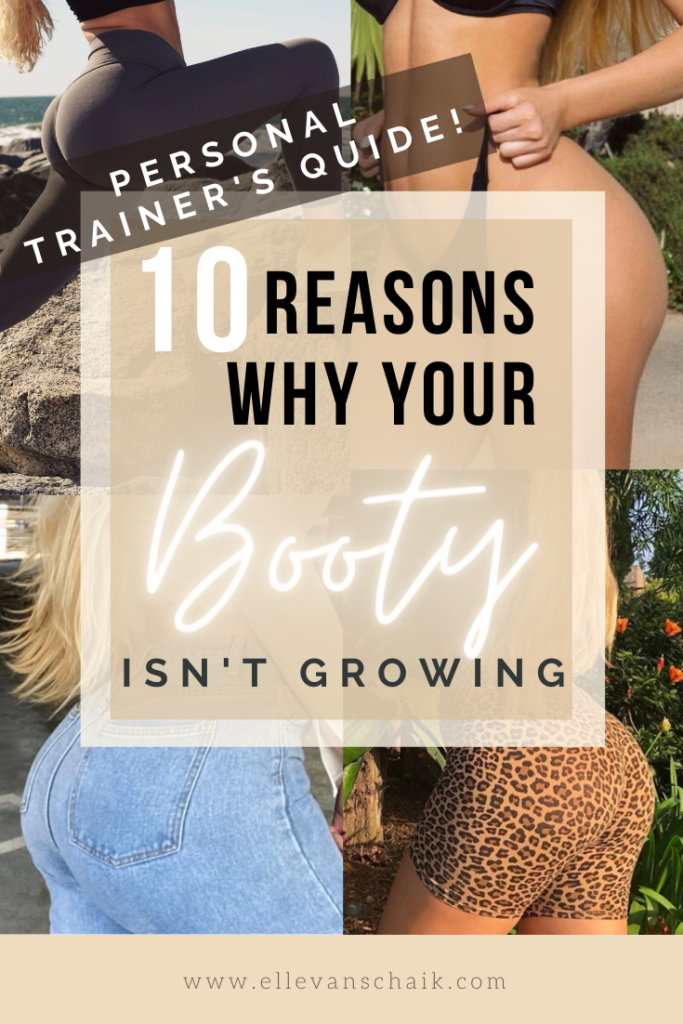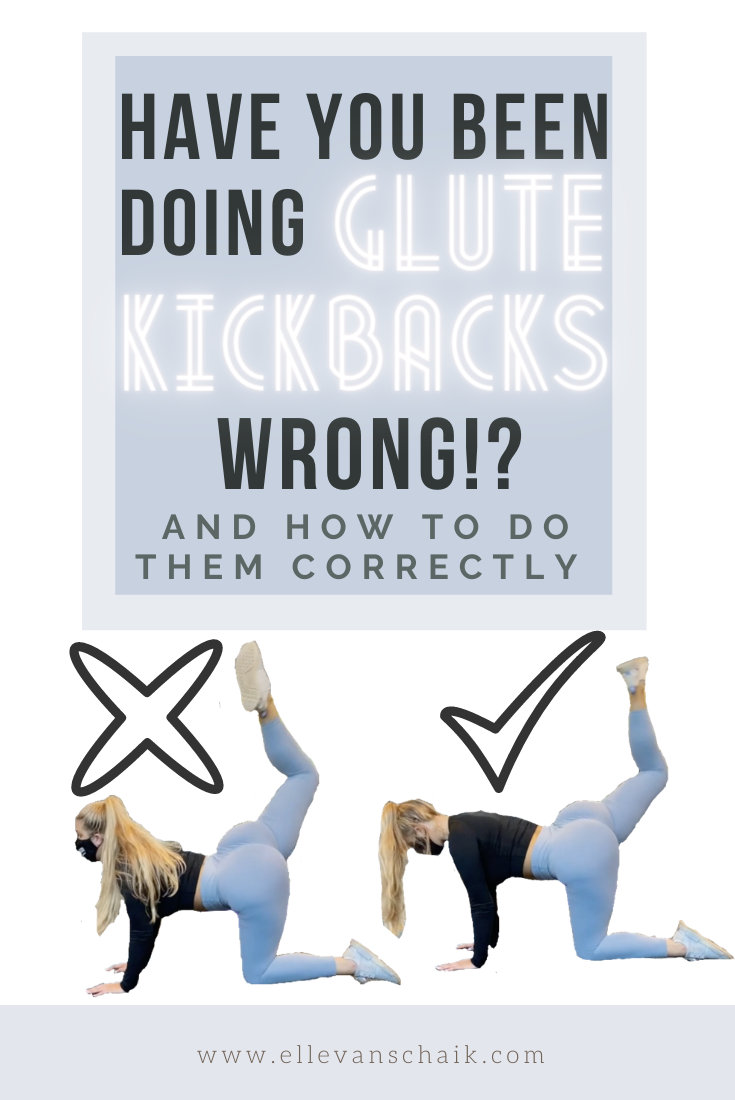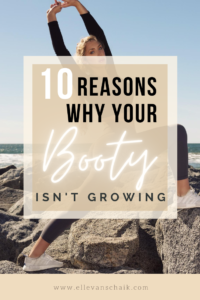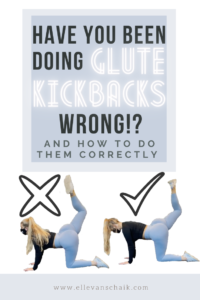We all want that nice, perky, bubble butt, but what happens when you have been working hard in the gym and aren’t seeing any results? Or maybe your results have plateaued. Growing a booty requires a lot of to work hard but there is a lot more too it than most fitness influencers lead on. It is important to focus not only on working hard but also working smart and using science in your favor to make those stubborn glutes grow. Here are 10 reasons and solutions as to why your glutes might not be growing.

1. You’re Doing Too Much Cardio
Are you working you a** off in the gym. . . literally working your a** off? This might be because you are doing too much cardio. There are mixed feelings in the fitness industry about the weather cardio can hurt your gains or not. My personal opinion is if you are trying to build a booty, cardio is okay as long as it is not in excess.
A lot of cardio can cause you to be in a caloric deficit. A caloric deficit means you are burning more calories than you are consuming. Over time this will cause you to lose weight and potentially lose some of that booty you worked hard for. If you are able to do a lot of cardio, lift weights and still consume enough calories to avoid a caloric deficit then go ahead a run all the miles you want. But it is often challenging to do a lot of cardio, lift weights, and consume enough of the HEALTHY calories. I’m not saying don’t do cardio at all, I’m just saying don’t go run 6 miles a day and not eat enough if you are trying to build a booty.
2. You Are Doing Cardio Before Resistance Training
On the days where you are doing cardio and resistance training (lifting), you should start with your resistance training and finish with cardio. This is because your body will burn more fat when doing cardio at the end of a workout as opposed to doing it in the beginning.
Think about your body as a highway with glycogen (stored carbs) on the highway and fat cells on the ramp trying to get on the highway. Your body prefers to burn glycogen so glycogen is going to be speeding down the highway being burned but with all the glycogen in the way, it is hard for fat cells to get on the highway and also be burned. But once the glycogen has passed by it is easier for the fat cells to get on the highway and be burned. So if you lift weights prior to cardio your body will burn all it’s stored glycogen during your weight training. Then once it is time for cardio your body will have gone through a lot of its glycogen storage and will then be forced to burn fat. I know kinda confusing but make sense?
Another reason why you should do cardio after your weight training is if you are trying to build muscle you want to get as much as possible out of your weight lifting session. If you exhaust yourself by starting off with cardio you will not be able to lift as much, progressive overload your workouts, and just not push yourself as hard.
3. You Are Not Doing The Right Exercises
The majority of people think squats are the number one exercise for growing the glutes aka the booty. I have personally seen countless women and men in the gyms doing squats, after squats after squats. This is because social media has given out false info for years, convincing people that glute growth is all about squats. Yes, squats are a great exercise but if your main goal is to grow the glutes, this would not be the first exercise I would go for. This is because squats focus on the entire leg, the hamstrings, quads, and the glutes. But if you want that juicy booty you need to focus more on exercises that isolate the glutes. Here are some examples of exercises that are much better than squats for targeting that booty:
- Hip Thrusts – my personal favorite!
- Bridge Movements like glute bridges
- Glute Kickbacks and Donkey Kicks
- Frog Pump or Frog Thrusts
- Kettle Bell Swings
- Hip Abduction Exercises (when you bring your leg to the side like laying lateral kicks or lateral band walks)
Prioritize these movements in your training but do not completely shy away from other lower body exercises like squats, deadlifts, or lunges. Variety is good so switch it up. Check out my Instagram post with a video of how to perform these exercises here. (coming soon!)
4. Your Glutes are Asleep
Have you ever done a killer leg workout but felt almost nothing in your butt? Instead, you felt a lot in your quads and hamstrings? This is because your glutes are not firing up properly and are basically asleep. The average American sits for the majority of his or her day. All this sitting overtime causes our glutes to become inactive, and as a result, we become more quad dominant.
If this is the case for you, start your workouts with glute activation exercises. My personal favorites are glute kickbacks or banded lateral walks. Glute activation exercises focus on firing up the glutes, bringing blood flow to the muscle, and on building the mind-muscle connection.
The mind-muscle connection is when you train your mind to internally focus and target the primary muscle of a movement as opposed to secondary muscles. For example, with a Romanian Deadlift (RDL), the main muscles being worked are the hamstrings and the glutes. However, if you do not focus correctly on the hamstrings and glutes the lower back can start to take over. Glute activation exercises train your glutes to fire up and prepare you for your workout. Check out my Instagram post with my favorite glute activation exercises here.
Hip circles or booty bands are great inexpensive workout tools, that can help you activate your glutes. A high-quality hip circle I personally recommend is the SlingShot Hip Circle.
Shop My Fit Favs
5. You Are Not Eating The Right Foods
There is a common myth within the fitness industry, that in order to gain significant muscle you need to be bulking. Yes, this is one strategy and it works for some but you don’t need to be eating in an excessive surplus to gain muscle. I mean think about it do you really want to have a huge butt but be overweight? Defeats the purpose. You are no longer as healthy and you have gained weight everywhere which doesn’t help your booty look bigger, it might even look smaller. 😱
There are a lot of conflicting opinions out there when it comes to food, diets, and building muscle. But one thing always remains true, healthy whole foods are the key. Healthy carbs, fats, and proteins are much better than processed, high sugary, and low-quality foods. For example, carbs like vegetables and whole grains are healthier than cereal. Excess sugar is something to avoid because your body will store it by turning it into fat, oftentimes stored around the midsection.
Eating enough protein is essential to repairing and building your muscles. However, A lot of people think you need to go crazy and eat as much protein as possible to build muscle. I disagree and suggest a general rule of thumb for protein intake is .8-1gram of protein per pound of your weight. I like to supplement my diet with protein powder to ensure I am getting enough protein every day. My favorite protein powder is the Orgain Protein Powder, it is plant-based yet still provides 21g a protein per a serving AND it doesn’t taste bad, which is surprisingly hard to find with plant-based protein powders.
It’s important to enjoy what you eat so you can sustain this lifestyle. If you hate your diet it won’t last. Ask yourself when you are thinking about your diet “can I maintain this diet for years or the rest of my life?” If the answer is no it’s probably not going to last. Long term diet is more important than short fad diets.
Also, as mentioned earlier if you are not eating enough your body is in a caloric deficit which overtime can cause you to lose weight and maybe even that booty you have worked hard for.
6. You Are Not Lifting Enough: Frequency and Weight
Frequency:
Maybe you are not lifting frequently enough or you are not lifting enough weight. To see some serious booty gains you should be working on your legs and glutes 2-3 times a week. The glutes are one of the largest muscles in the body, so it can handle working out a few days a week.
It is smart to use your workout intensity and types of exercises to help you determine how many days a week you should be lifting the glutes. If you are really pushing yourself every workout it is most likely counterproductive to lift legs more then 3 times a week.
The types of exercises you are doing during your workouts will also determine the number of days a week you can workout. For example, movements with a large range of motion like RDL’s, lunges, and hip thrusts, cause a bigger stretch in the muscle and result in more muscle damage. More muscle damage in turn means more time is needed to recover. Also, exercises like squats and deadlifts put a big systemic load on the body by using a lot of muscle groups. This can really tire the body out and require more days to recover from these intense exercises.
However, more isolated movements with a smaller range of motion, like lateral band walk, abduction movements (when you bring your leg to the side, like laying lateral kicks) and frog thrusts don’t cause as much muscle damage so are able to be performed more frequently. I personally like to lift my legs 2 times a week, mixing up heavy days with compound movements and lighter days with more isolated movements.
Some people are able to work large muscle groups, like the glutes, up to six times a week. This all depends on your body and your ability to recover. Some people have better recovery genetics and can handle that type of stress on the body while others can’t. I would suggest if you want to work out your glutes more take it slow. Start with 2 days a week and do that for a month or so then slowly progress and listen to your body.
7. Weight:
During your workouts, you want to make sure you are pushing yourself with the weight. Whether you are lifting 6 reps or 12 reps if you don’t feel a challenge in the last few repetitions, it is time to go up in weight. The key is to make sure you are progressively making the workouts harder, with progressive overload. This can be done by increasing the weight, increasing your reps and sets, increasing range of movement, increasing time under tension (a longer time period of resistance), or decreasing rest periods.
8. You Are Not Mixing it Up
In the past, fitness enthusiasts all thought hypertrophy (building muscle) was all about lifting as heavy as possible all the time. But recently, there have been new studies that suggest incorporating both heavy, low rep days and lighter weight, high rep days is the most beneficial for muscle growth. Muscle growth is all about making an exercise progressively more difficult or progressive overload. When each set is taken to failure (when you can no longer complete an exercise because of muscle fatigue) there are actually similar levels of muscle growth for both high rep and low weight exercises and low rep and high weight exercises.
There are also different types of muscle fibers that are being activated during high rep and low rep workouts so mixing it up will make sure you strengthen and grow both these different types of muscle fibers.
Lastly, if you do the same exercises, weights, and reps for every workout your body will get used to it which can lead to a plateau. Variety is always good and pushing your body in different ways will lead to more stress on the body leading to more results in the long run.
9. You Are Not Giving Yourself Enough Rest
One way muscle is built is by tearing down the muscle fibers. When you work out your muscles get a lot of micro-tears. Your body will then repair these tears and your muscles will come back stronger and bigger. However, it takes rest and time for your muscles to recover, and if you aren’t giving your body the time it needs to rest a large part of the muscle-building process is being cut short.
Always listen to your body if you are still VERY sore from your last leg workout maybe give it another day. A little bit of mild soreness is no biggy but if you are feeling deep soreness and still feel weak from your last workout that is an indicator you should give it a little more time to recover. A good rule of thumb is to make sure to have at least one rest day in between each leg day.
Too much soreness all the time can actually be counterproductive because it stops you from being able to achieve progressive overload and work out as frequently. Progression is more important then sensations like soreness.
If you having killer leg days three times a week, and you are not getting the proper rest and recovery, you could eventually burn out and start experiencing overtraining. Depending on the severity of the overtraining it can hurt you more in the long run.
If you feel tempted to skip your rest days and continue to do another gym session, try mixing in active recovery days. Active recovery days can incorporate stretching, going on a walk, yoga, or foam rolling. One of my favorite things to do on active recovery days is foam roll, a great foam roller to try out is the TriggerPoint Foam Roller.
10. You Are Inconsistent
This might be the most important. Seeing any results with any muscle, especially the glutes, takes time, patience, and consistency. As a personal trainer and I have seen countless women talk about how they want to build their booty but then they train hard for two months then take a month off. Find a workout program that works for you, that you can stick to and push yourself. Make fitness a part of your lifestyle and a habit. The first few months are always the hardest but I promise it gets easier with time and consistency. Also, don’t get discouraged if you aren’t seeing results. If you are doing what you are supposed to be doing the results will happen. Just stay consistent and be patient.
Shop This Blog Post









Love your fitness article, and you hit it in the nail. Inconsistencies and lack of commitment are hurles that people must overcome if they expect results.
You will go far, keep up the articles.
Thank you, Neven! I’m glad you enjoyed it! 🙂
I love you 💘!!!!!!!
Thank you Miguel! 💖